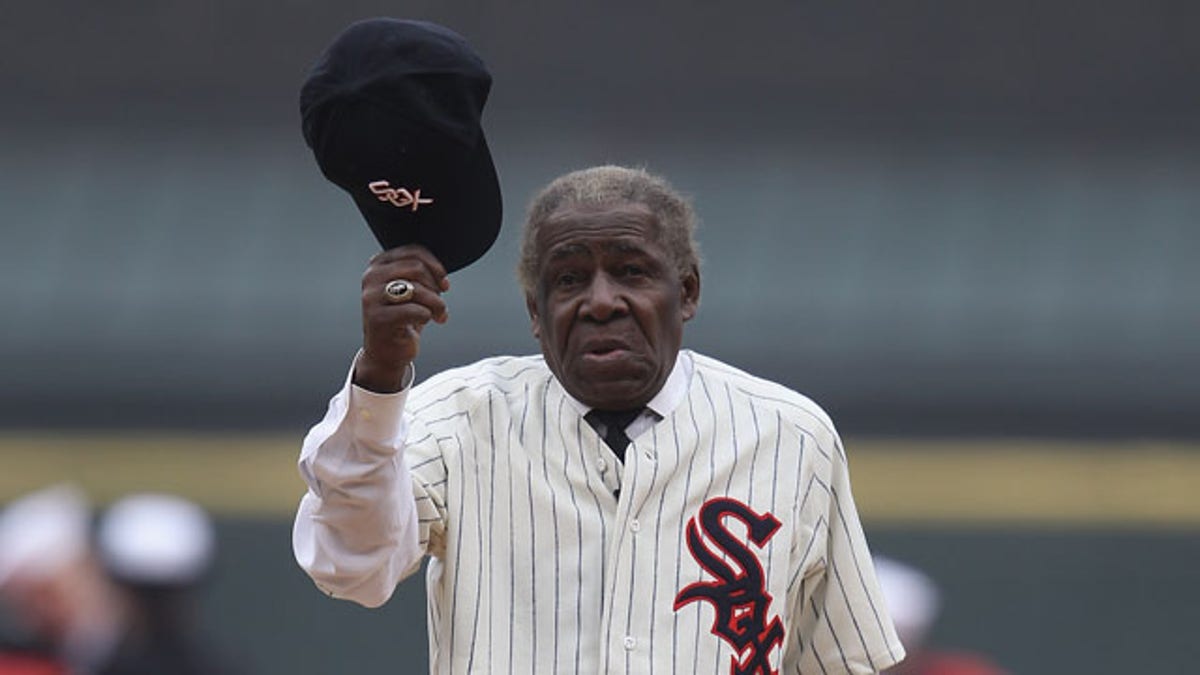
CHICAGO, IL - APRIL 07: Six time All-Star Minnie Minoso waves his hat to the crowd as he's introducted to throw out a ceremonial first pitch before the home opener between the Chicago White Sox and the Tampa Bay Rays at U.S. Cellular Field on April 7, 2011 in Chicago, Illinois. (Photo by Jonathan Daniel/Getty Images) (2011 Getty Images)
Saturnino Orestes Armas Minoso Arrieta died a few days ago in Chicago. Baseball fans knew him as Minnie Minoso, the second Black player in Major League Baseball’s American League; the first Black Hispanic star.
Before the majors, he played center field on the Triple AAA San Diego Padres in San Diego, California. The team played in Lane Field, a wooden stadium with 10,000 seats on San Diego Bay.
He called me “Chico.”
He was so popular that one night in my neighborhood theater we were watching a movie about revolution in Cuba in which there was a scene of a Black Cuban carrying a machete and I cried “Minnie Minoso!” and the audience started clapping.
I was the luckiest kid in San Diego in 1949. My mother married my stepfather, a rookie San Diego police officer who was earning $150 a month as a police officer. He moonlighted as security at the “wrassling” and boxing matches at the downtown Coliseum, just a mile from my home at night and at daytime weekend baseball games of the Pacific Coast League San Diego Padres, the very team my cousin Ted Williams had played for before he went to Boston and I arrived from Mexico.
I was a big fan of Gorgeous George and hated Mr. Moto of professional wrestling. I adored my neighbor Light Heavyweight Champion of the world, boxing’s premier knockout artist, Archie Moore, the Mongoose, who had 105 knockouts in his career and was the only man ever to knock Heavyweight Champ Rocky Marciano off his feet.
It was my pleasure to go to the fights and to “wrassling” when my step-father worked them; it was free and delightful to yell and scream along with a couple thousand others. I got to meet all the wrestlers and boxers. I even met “Pappy” Boyington, the famous U.S. Marine pilot that shot down 26 Japanese planes in World War Two who was the first Medal of Honor winner I met. He was a referee.
I knew it was a big deal because my Navy veteran step-father didn’t like Marines but he like Boyington who refereed “wrassling” matches. My high school Graphics Arts teacher who flew with Boyington’s famous “Black Sheep” Marine fighter squadron introduced “Pappy” to me. Much to his surprise, “Colonel Boyington” tousled my hair and said, “I remember you from the Coliseum.” Good memory ten years later.
But my real pleasure came on Saturday and Sunday afternoons during baseball when my step-dad worked security for Padre Games. We entered the park through the ball player’s entrance; I got to go on the practice field and shag balls for the players. I met a skinny Mexican American pitcher named Enrique “Hank” Aguirre who later was a star pitcher with the Detroit Tigers. I played catch with a huge guy named Luke Easter the first Black player in the American League. But my favorite was Minnie Minoso. He taught me how to slide into second base. He led the majors in triples and stolen bases three times each, he was that good.
Out of Mexico just six years, my Spanish was good and because his English wasn’t, the Cuban enjoyed having me around because when he needed help with a word, I helped him just like I helped my grandmother who never learned English.
He was so popular that one night in my neighborhood theater we were watching a movie about revolution in Cuba in which there was a scene of a Black Cuban carrying a machete and I cried “Minnie Minoso!” and the audience started clapping.
We lost him in San Diego when the parent Cleveland Indians called him up to join Luke Easter. He played 17 seasons in the American League, 12 with the Chicago White Sox. He was the first Black on the Chicago White Sox.
Minnie Minoso had a .298 lifetime batting average and career 186 homers and 1,023 RBIs. He also led the American League in triples and steals three times in each category. He made the American League All-Star team nine times.
Another Cuban ball player, Chicago White Sox shortstop Alexei Ramirez says, “I think that everybody has to respect his legacy because he did so much for the Latin players, for the Cubans, for everybody because when he arrived here it was a tough time because of racism and discrimination. He wrote a huge legacy for all of us.”
That’s well and good but I remember him best for running back toward the center field wall at Lane Field one Saturday afternoon in 1949, turning and realizing that the ball was hit too high and would be a home run, he threw his mitt into the air and knocked the ball down.
The opposing manager came flying out of his dugout screaming that it was a fair home run; the crowd booed him, the umpires agreed with him, the crowd booed them.
The next day at batting practice, Minnie threw his mitt up and laughingly asked me in Spanish if I enjoyed his play to stop the home run the day before. We laughed and I threw my glove up in the air. We laughed more.
He died Sunday March 1st, he was 90 years old.




















